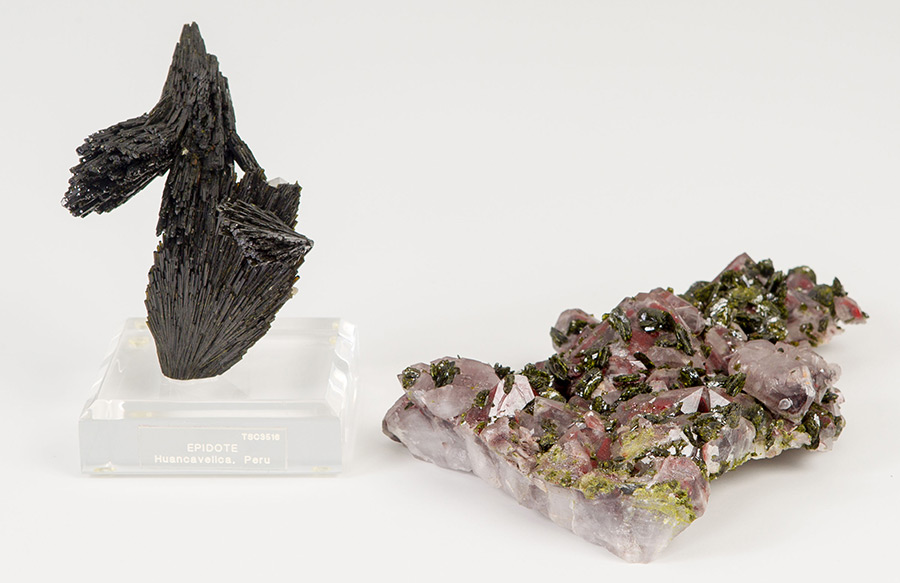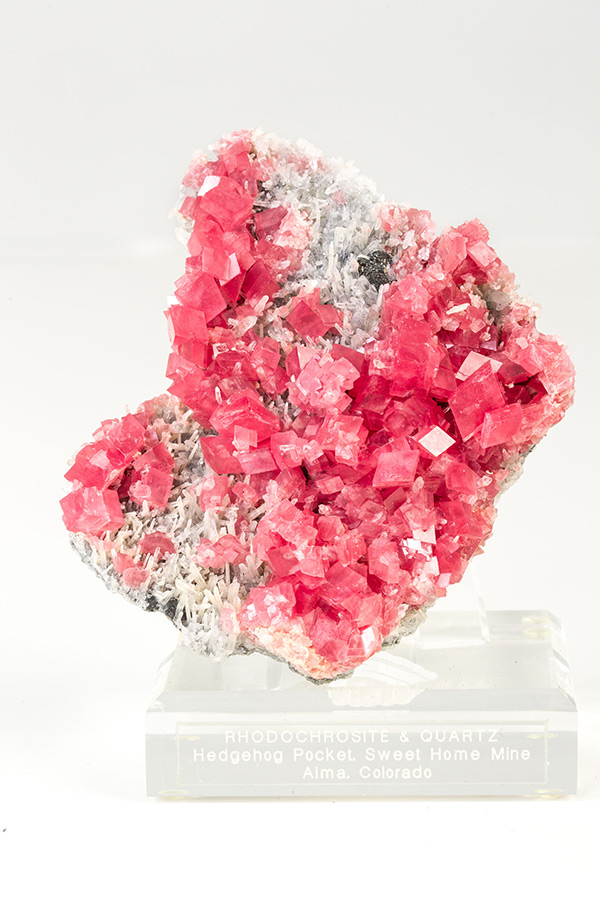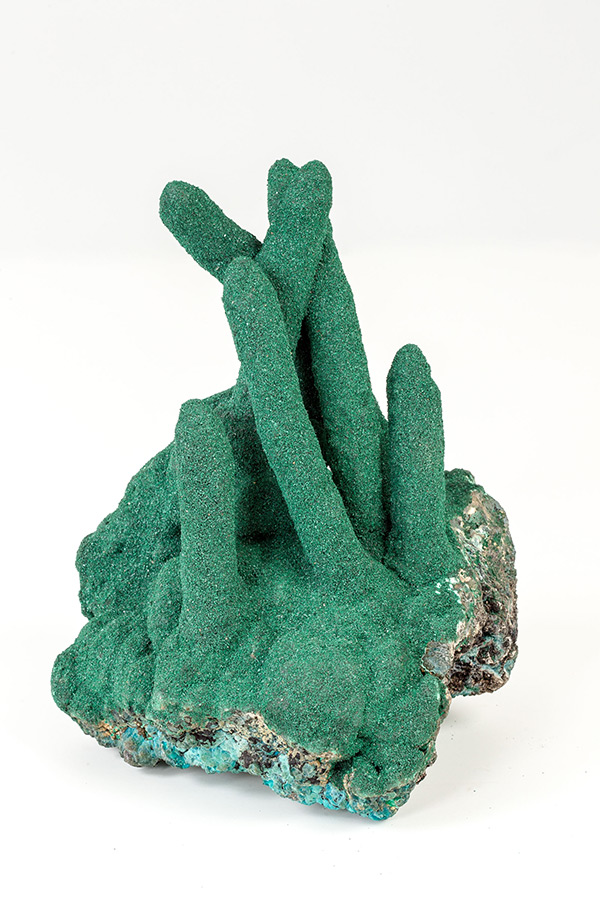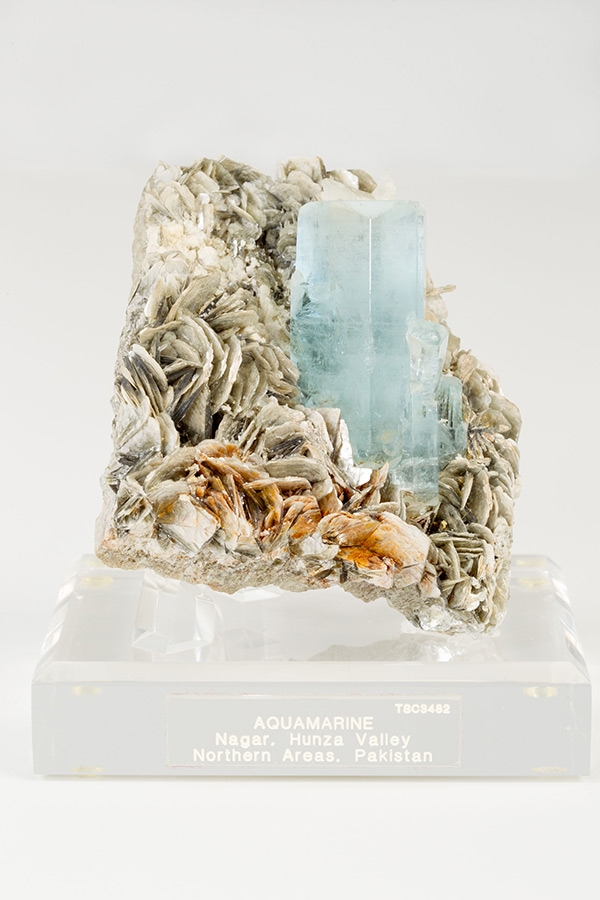
Minerals from around the world have been donated to Appalachian State University’s Department of Geology and McKinney Geology Teaching Museum. They illustrate the diversity of the earth’s geology and represent a natural gas industry geologist’s lifelong passion for collecting. The collection includes examples of epidote, a metamorphic silicate mineral from Peru, above, and China. Photo credit: Marie Freeman
BOONE—A collection representing one man’s lifetime fascination with minerals has been donated to the Department of Geology at Appalachian State University. It will be featured in a series of exhibits in the department’s McKinney Geology Teaching Museum located in Rankin Science Building.
The collection of the late James E. Wilson includes more than 200 museum quality specimens, including aquamarine from Pakistan, a bright green malachite stalactite from Zaire and rhodochrosite, a pink to red manganese carbonate mineral from Colorado.
A graduate of Rensselaer Polytechnic Institute, Wilson worked as a geologist in the natural gas industry in the eastern United States, including Pennsylvania, West Virginia and eastern Tennessee before retiring to Florida. He was an avid collector, starting as a teenager, and in later years traveled to various mineral shows, according to his wife, Corrine. Wilson died in 2013.
It was the family’s wish that the collection, which occupied seven display cases in the Wilsons home, be publicly displayed.
“It’s a splendid collection, with many stunning individual specimens from around the world,” said Professor Andy Heckert, a professor in the Department of Geology and director of the McKinney Geology Teaching Museum. “Once it’s installed, I think you’ll have to go hundreds of miles from Boone to find more exquisite specimens, and there are plenty of fine places to see minerals here in the High Country.”
Retired geology professor Richard Abbott agreed. “These specimens are of the quality you would find in the Smithsonian,” he said. “For many of these minerals, there is nothing in the department’s existing collection that even comes close to the quality and diversity it represents.”
Wilson and his wife knew of Appalachian and the reputation of its geology department, whose graduates often pursue careers with the oil and gas industry. Appalachian was one of three academic institutions or museums considered for the gift.
Geology lab coordinator Anthony Love traveled to Florida to pick up the collection and has helped inventory its holdings. “It will make our museum more dynamic,” he said. Future exhibits could focus on the mineral type or locality of the specimens, including the Appalachia region which is represented by minerals such as garnet sphalerite, calcite fluorite and dolomite.
“That is part of the value of this collection,” Love said. “Almost anyone can walk up and appreciate any one of these specimens and that might garner someone’s interest in becoming a geologist or chemist.”
Once the specimens are catalogued, Heckert hopes the first exhibit from the collection will be on display in mid-March, giving the public a first-hand look at the variety and beauty of the collection.
“People do not appreciate that minerals are more than pretty rocks. Exquisite crystals are literally scale models of the chemistry at an atomic level,” Heckert said. “To a geologist, minerals are the ingredients, the building blocks, of rocks. Usually, mineral crystals are microscopic, or maybe only a few millimeters long, and natural crystals are seldom perfect, as they grow into each other and interlock. The James Wilson collection specimens are fantastic examples where crystals grew in perfectly ideal conditions, probably in hydrothermal (hot water) conditions, so that they are positively gigantic relative to normal crystals.”
About Appalachian State University
As a premier public institution, Appalachian State University prepares students to lead purposeful lives. App State is one of 17 campuses in the University of North Carolina System, with a national reputation for innovative teaching and opening access to a high-quality, cost-effective education. The university enrolls more than 21,000 students, has a low student-to-faculty ratio and offers more than 150 undergraduate and 80 graduate majors at its Boone and Hickory campuses and through App State Online. Learn more at https://www.appstate.edu.
What do you think?
Share your feedback on this story.














